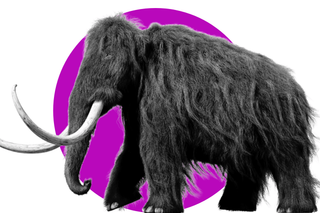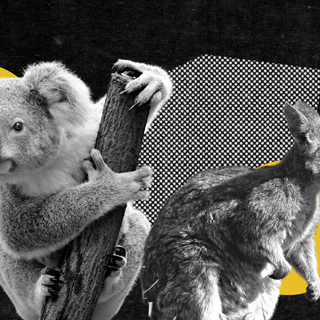
Scientists Plan to Revive Woolly Mammoths, Raising Bioethical Concerns
Woolly mammoths could help stall climate change by preventing emissions from the Arctic permafrost, but the idea has ethical ramifications.

Species de-extinction may soon make the voyage from reel to real life. A new bioscience company Colossal, whose co-founder George Church is a Harvard geneticist who has led the effort to advance de-extinction, is on the verge of bringing woolly mammoths back into the world. Woolly mammoths roamed the Arctic tundra for more than 800,000 years before going extinct 4,000 years ago.
Colossal’s technology uses DNA sequences of the ancient species collected from Arctic ice to create an elephant-mammoth hybrid by inserting the DNA into an Asian elephant genome.
According to Church, the technology is just two years away from actually creating the hybrid embryo. A gene-editing tool, CRISPR, will splice specific mammoth traits into endangered Asian elephant DNA. These include a shaggy coat, subcutaneous fat stores, smaller ears, and the signature long curved tusks.
“In addition to bringing back ancient extinct species like the woolly mammoth, we will be able to leverage our technologies to help preserve critically endangered species that are on the verge of extinction and restore animals where humankind had a hand in their demise,” said Ben Lamm, founder of Colossus, in a press release.
This ambitious genetic endeavor aims to preserve the endangered Asian elephant in an altered form simultaneously and revive the Arctic grasslands and help stall climate change in the process. The idea is that the woolly mammoths act as “natural geo-engineers.” Their trampling all over the landscape, uprooting trees in the process helps maintain grasslands. These grasslands, in turn, are vital for preventing carbon and heat trapped in the ice from escaping into the atmosphere and advancing global warming in the process.
At present, dead plant life in the permafrost could release enough greenhouse emissions into the atmosphere to warm the Earth even more than the current predictions if the ice thaws.
However, just because we can bring woolly mammoths back doesn’t mean we should, according to some bioethicists. This debate has been around for a while: should bioethics evolve to allow room for climate change alleviation strategies? Many believe so.
“I don’t know if bringing the mammoth back is the right approach, but at the moment we lack a decent solution for keeping the giant Arctic carbon deposits in the ground,” Paul Mann, a professor of geography and environmental sciences from Northumbria University, Newcastle, wrote in The Conversation.
However, others are wary of tampering with species revival and embryonic manipulation.
“The proposed ‘de-extinction’ of mammoths raises a massive ethical issue – the mammoth was not simply a set of genes, it was a social animal, as is the modern Asian elephant. What will happen when the elephant-mammoth hybrid is born? How will it be greeted by elephants?” Matthew Cobb, professor of zoology at the University of Manchester, told The Guardian.
Related on The Swaddle
What Is Transhumanism and Why Do People Associate It With Eugenics?
Yet others have raised concerns that the project would require many Asian elephant surrogates carrying a different species before an actual baby mammoth is born, risking their lives and much more. Colossus has at present guaranteed that it will not use real surrogates.
The mammoth resurrection project has been ongoing for a while in other parts of the world too. Another strategy in South Korea involves inserting a mammoth cell nucleus into an elephant egg. This is a process called cloning, which is another bioethical beast to tackle together.
The climate change argument itself does not fully convince some experts.
“The problem here is that we don’t yet fully understand the role of the woolly mammoth as an ecosystem engineer, and it is unclear still whether the mammoth steppe disappeared as a result of the loss of the mammoth or whether the mammoth disappeared because its habitat was lost, along with its ice age world,” writes Tori Herridge, a paleobiologist from the Natural History Museum in London.
“It’s a big gamble to put your climate-change mitigation hopes on a herd of woolly mammoths – and if it did work, it would require numbers in the hundreds of thousands to have an effect,” she adds.
Further, even those who refute the validity of the claim that the grasslands were compromised because of mammoth extinction.
Adrian Lister, another researcher of mammoths and their relationship with people and the environment at the Natural History Museum, had this to say: “That is not to deny that megafauna can have an impact on local vegetation, as we know from modern examples, but… we shouldn’t kid ourselves that we are smart enough to predict all the possible unintended side-effects.”
Still, those behind the project claim that “this is going to change everything.” But even without the bioethical concerns, experts remain skeptical. “I still wonder what the bigger point would be. First of all, you’re not going to get a mammoth. It’s a hairy elephant with some fat deposits,” Love Dalén told CNN from the Centre for Palaeogenetics in Stolkholm.
For all the bluster, we may not see a live mammoth for a while if previous attempts to resurrect extinct species are anything to go by. Even if we do, it may well serve as a curiosity rather than actually contributing to the fight against climate change. Either way, the issue has drawn fascination and concern in equal measure, and scientists are waiting to see what comes of the bold experiment after all.
Rohitha Naraharisetty is a Senior Associate Editor at The Swaddle. She writes about the intersection of gender, caste, social movements, and pop culture. She can be found on Instagram at @rohitha_97 or on Twitter at @romimacaronii.
Related


‘High Profile’ Users Often Get a Free Pass to Violate Facebook’s Rules: Report
